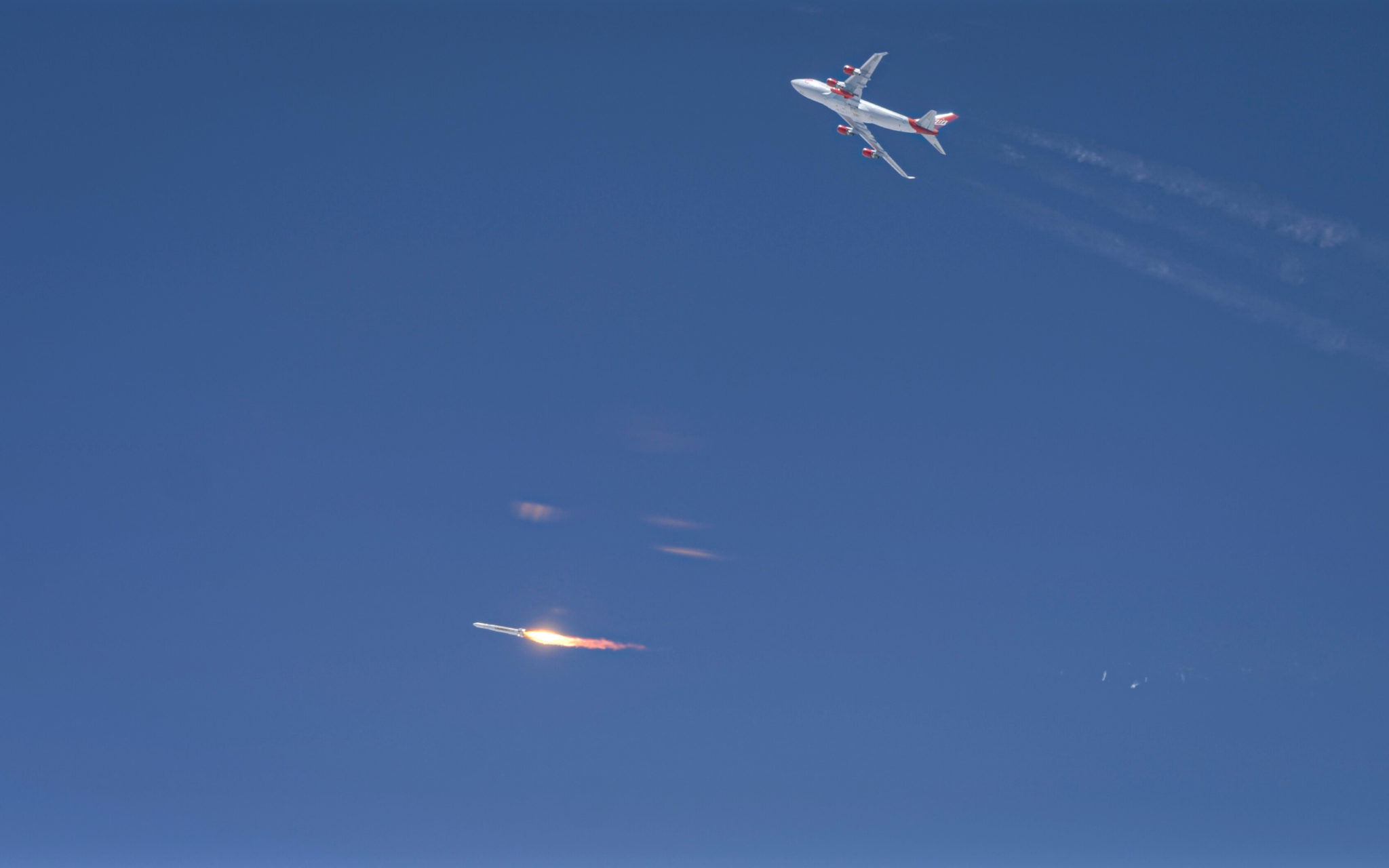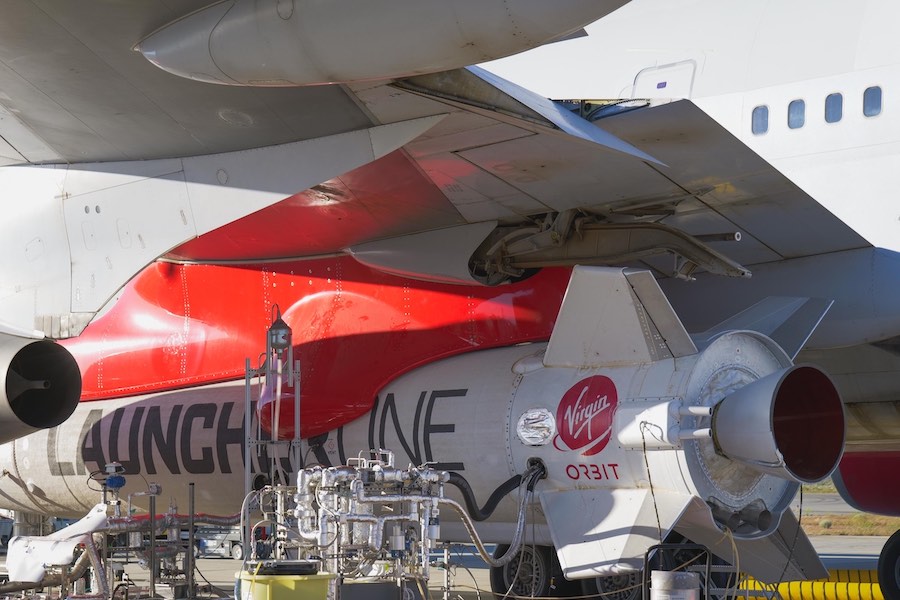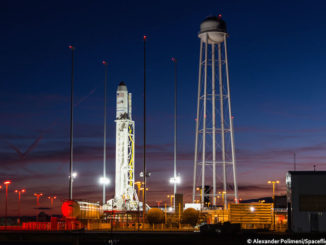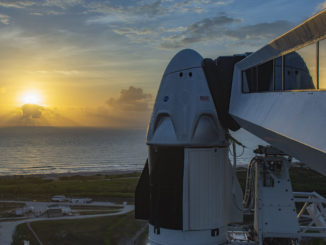
An engine failure that cut short the first test flight of Virgin Orbit’s air-dropped LauncherOne rocket in May was caused by a faulty propellant feed line, the company’s CEO said this week.
Virgin Orbit’s first orbital launch attempt May 25 ended seconds after the rocket’s release from a Boeing 747 carrier jet over the Pacific Ocean. Dan Hart, Virgin Orbit’s CEO, said Wednesday that engineers traced the cause of the premature shutdown of the first stage’s engine to a break in a propellant feed line.
The 70-foot-long (21-meter) LauncherOne rocket is designed to place small satellites into orbit. The first test flight of the air-launched rocket in May was the culmination of years of development, including numerous engine tests and test flights of the modified Boeing 747 carrier aircraft.
Hart said Wednesday that Virgin Orbit, part of Richard Branson’s Virgin Group, collected enough data on the flight to prove the rocket’s aerodynamic control algorithms, and to determine the cause of the first stage engine failure.
“The moments after dropping the rocket — in that data – -we verified our entire aerodynamic database as we dropped the rocket off the airplane,” Hart said Wednesday in a webinar with the Space Generation Advisory Council, an advocacy organization for students and young space industry professionals. “We verified our control algorithms as our fins worked really hard to control the rocket through the turbulent flow around the airplane, and into the steady state flow as the rocket dropped through the air for about four or five seconds.”
“The rocket detected that it was time to start the engine, and it went through its pressurization and startup routine, started the engine and lifted up its nose, and pulled up pitch and traveled along our trajectory to target the orbit,” Hart said. “So we were pretty stoked at that point that we had, at that moment, proven all of the new aspects of air launch.”
The LauncherOne rocket is the first air-launched orbital-class vehicle with liquid-fueled engines. Northrop Grumman’s Pegasus rocket, which is also deployed from an airplane, uses solid rocket motors.
“A few seconds later, unfortunately, and to our disappointment, we had our component break in our engine system,” Hart said. “It was a high pressure feed line, and LOX (liquid oxygen) stopped going into the engine, and our flight was terminated. So we left both incredibly excited, incredibly thrilled, and a bit disappointed that we didn’t get into orbit.”
The LauncherOne rocket’s first stage is powered by Virgin Orbit’s NewtonThree engine. Fed by kerosene and liquid oxygen, the engine can generate about 73,500 pounds of thrust during the first three minutes of the launch sequence.
An upper stage NewtonFour engine is designed to finish the job of placing satellites into orbit.
Hart said Virgin Orbit has identified a fix for the liquid oxygen feed line problem.
On a first flight, on any flight in spaceflight, data is so critical,” he said. “We had four ground stations tracking us, and I’m really glad we did.
“So we’ve got our next rocket in final integration right now,” Hart continued. “It should be leaving the factory in the next few weeks and heading into launch processing while we make some modifications to the engine to strengthen up those parts. And we’ll be targeting our next flight before the end of the year.”

Virgin Orbit staged the first LauncherOne demonstration flight out of Mojave Air and Space Port in California, where ground crews loaded the rocket onto a pylon under the left wing of the company’s carrier aircraft, nicknamed “Cosmic Girl.”
After taking off from Mojave, the Boeing 747 carrier aircraft flew west, then turned south over the Pacific Ocean en route to a drop point roughly 100 miles (160 kilometers) west-southwest of Long Beach at an altitude of around 35,000 feet (10,700 meters). Two pilots and two launch engineers were aboard the carrier jet, which pitched up to an angle of nearly 30 degrees before releasing the LauncherOne rocket.
Before the May test flight, Hart said the data gathered on the first launch would anchor engineering models that have, so far, only relied on testing performed on the ground or in the atmosphere. Hart said this week that the performance of the 747 carrier aircraft, its release system, and the airborne ignition of the LauncherOne rocket proved key parts of the system Virgin Orbit developed.
“It was not easy making the modifications (to the 747) to put a big pylon on the wing, and modify the wing, and all the electronics, cabling and plumbing and pressurization,” Hart said. “All of that was very complex. I mean, we had to develop two vehicles.”
Three hooks hold the rocket to the Boeing 747 jumbo jet, which was modified from earlier use as a passenger airliner by Virgin Orbit’s sister company Virgin Atlantic.
“Having now gone through the flight test program, we’ve sort of worked through the development and verified it,” Hart said Wednesday. “So it’s a very reliable system. The whole point of the system we created was to create it as simple as possible.”
Virgin Orbit, and its subsidiary VOX Space focused on the U.S. military satellite launch market, has secured deals to launch small payloads for NASA, the Pentagon and commercial operators. The company has confirmed missions to fly from bases at Mojave and Guam, and could fly from runways at the Kennedy Space Center in Florida, Britain, Japan and other sites in the future.
The flexibility provided by flying from multiple airports around the world is a key advantage, Virgin Orbit says.
Before the May test flight, Hart said Virgin Orbit has initially set a launch price of about $12 million per LauncherOne flight, but that could be divided among multiple customers if their satellites are light enough. The LauncherOne vehicle can deliver a payload of up to 1,100 pounds (500 kilograms) to a low-altitude equatorial orbit, according to Virgin Orbit.
The debut test flight capped years of development of Virgin Orbit’s small satellite launch system. The effort to develop the LauncherOne rocket began as a project of sister company Virgin Galactic, which focuses on the suborbital space tourism market.
Virgin Galactic says it first studied the LauncherOne concept in 2007, and development began in earnest in 2012. Engineers in 2015 scrapped initial plans to drop the rocket from Virgin Galactic’s WhiteKnightTwo carrier aircraft, and kicked off development of a redesigned system using a 747 jumbo jet taken from Virgin Atlantic’s commercial airline fleet.
Headquartered in Long Beach, California, Virgin Orbit was established in 2017 as a spinoff of Virgin Galactic. The company currently has around 500 full-time employees.
Virgin Orbit’s investors include Branson’s Virgin Group and Mubadala, Abu Dhabi’s sovereign wealth fund.
Email the author.
Follow Stephen Clark on Twitter: @StephenClark1.



